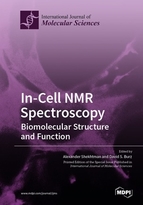In-Cell NMR Spectroscopy: Biomolecular Structure and Function
A special issue of International Journal of Molecular Sciences (ISSN 1422-0067). This special issue belongs to the section "Molecular Biophysics".
Deadline for manuscript submissions: closed (30 November 2018) | Viewed by 40330
Special Issue Editors
Interests: in-cell NMR technology; solution NMR spectroscopy; cellular metabolism and enzymology; receptor for advanced glycation end products (RAGE) structural biology
Special Issue Information
Dear Colleagues,
Life is an emergent property that results from vast arrays of molecules integrated into interaction networks. One of the ultimate questions of scientific inquiry is to understand how this property arises. Studying components of a cell in isolation does not accurately reflect the glaring complexity of physiological states that underpins the foundation of life. The ability to elucidate molecular structure at atomic levels under physiological conditions in the presence of transient interactions that are not present in dilute solutions has long been an elusive goal of cellular and molecular structural biologists. In-cell NMR spectroscopy, which utilizes atomic resolution NMR spectroscopy to study biomolecular interactions in live cells, brings us one step closer to realizing this goal by providing an unbiased look at the molecules engaged in physiologically relevant interactions within the complex environment of the living cell.
In this Special Issue we will discuss the state-of-the-art of in-cell NMR spectroscopy as it relates to the study of biological systems of increasing complexity compendia of research and recent innovations from prominent laboratories in the field of solid state and solution in-cell NMR spectroscopy, metabolomics, bioreactors and technology development will be presented with particular emphasis on what knowledge has been gleaned from in-cell work that is different from that deduced in vitro, and how that knowledge has contributed to our understanding of the emergent property of life.
Prof. Dr. Alexander Shekhtman
Dr. David S. Burz
Guest Editors
Manuscript Submission Information
Manuscripts should be submitted online at www.mdpi.com by registering and logging in to this website. Once you are registered, click here to go to the submission form. Manuscripts can be submitted until the deadline. All submissions that pass pre-check are peer-reviewed. Accepted papers will be published continuously in the journal (as soon as accepted) and will be listed together on the special issue website. Research articles, review articles as well as short communications are invited. For planned papers, a title and short abstract (about 100 words) can be sent to the Editorial Office for announcement on this website.
Submitted manuscripts should not have been published previously, nor be under consideration for publication elsewhere (except conference proceedings papers). All manuscripts are thoroughly refereed through a single-blind peer-review process. A guide for authors and other relevant information for submission of manuscripts is available on the Instructions for Authors page. International Journal of Molecular Sciences is an international peer-reviewed open access semimonthly journal published by MDPI.
Please visit the Instructions for Authors page before submitting a manuscript. There is an Article Processing Charge (APC) for publication in this open access journal. For details about the APC please see here. Submitted papers should be well formatted and use good English. Authors may use MDPI's English editing service prior to publication or during author revisions.
Keywords
- Solid-state in-cell NMR
- Metabolomics
- Solution in-cell NMR
- Bioreactors
- Cellular structural biology
- Macromolecular interactions
- Protein–small molecule interactions







